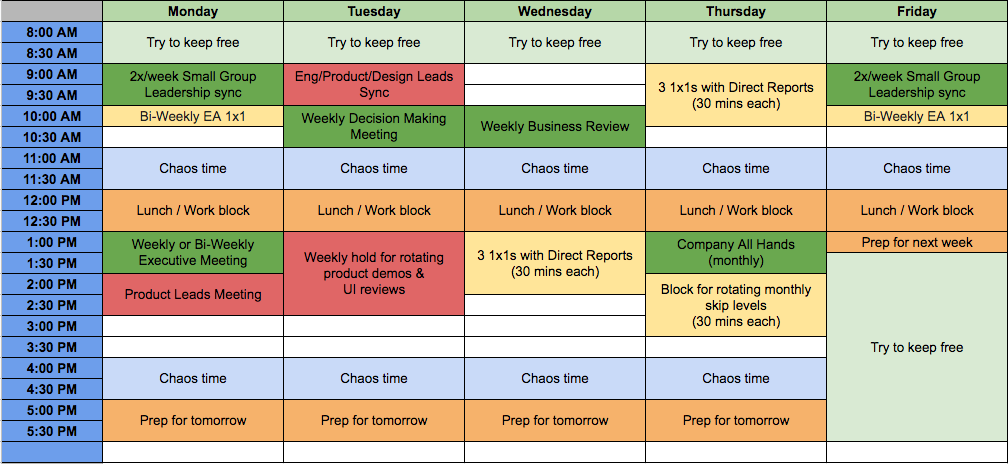Apply now to join Glue Club, the home base where the strongest startup leaders in the world come together to find sanity, opportunity, and growth amidst the chaos of building a company. I pour all my mentorship and coaching energy in to Glue Club, in case you’re looking for something more than a blog post… Head over here to learn more.
This piece is a companion to Mapping your company’s year, which talks about planning time efficiently as a company. A calendar skeleton helps you focus on your top priorities. Here’s a template – you’ll be able to copy it if you’re logged in to Google.
As an executive, everything flows from how you spend your time. You set a meeting, everyone rearranges their schedule. Time is emphasis, and your calendar very directly affects what gets done in the company and how you spend the dollars of the people who work for you.
Because I like being validated by smart people, here’s an HBR study that shows how important it is for senior operators to have clear priorities and calendar systems. The study analyzed the calendars of 27 CEOs, coding 60,000 hours. The study found that having explicit priorities and structure for your calendar and evaluating how you spend your time are some of the most important things you can do to end up spending the majority of your time on your strategic priorities.
When I work with leaders on time management, we start by clarifying priorities and then set up what I call a calendar skeleton. The skeleton is a template of a typical week that lays out time blocks for the core meetings and activities that happen on a regular basis. It’s the foundation for a living, breathing Google calendar, and it’s a way to get thoughtful about how activities flow into one another. It also makes time to handle chaos and unforeseen events so they don’t wipe out important work.
I’ll share some calendar template examples below, but it’s less about copying someone else’s system and more about HAVING a system in the first place. Map out how you want your weeks to flow, try it out, and revisit every 3-6 months.
The calendar skeleton
To create a calendar skeleton, I start with a blank slate (like this template) and drop in the most important recurring activities.
Here are two examples. This one’s for a business-focused CEO at a B2B SaaS company.
This is for a product-focused CEO.
Every leader has a different system. When I worked with him, Mark Zuckerberg used theme days. Mondays were leadership days, which focused on his leadership team meeting, 1:1s, and meals with his reports. Tuesdays, Wednesdays, and Thursdays were for half-day deep dives on his strategic priorities. When I worked with him at Facebook in 2011, those priorities were primarily big strategic product areas like mobile and platform. But those shifted every 6-12 months and so would his calendar.
Some CEOs prioritize unstructured thinking time by creating regular windows for it (e.g., every Wednesday or every day until 10am) — whether they do focused problem-solving or take advantage of the benefits of mind wandering. They also defend it by creating blocks of time that can be used for distracting things like external meetings. Bunching things like external meetings together can help reduce context switching, which helps with focus and creates clearings for creative thought.
As for me, I like to use Mondays and Fridays for my Small Leadership team meetings to get everyone on the same page, like a kickoff and a debrief for each week. Tuesdays are for diving into the business and product with functional reviews, demos, and flexible blocks where people can schedule decision-making meetings with me and other leaders. Wednesdays are good for 1:1s with direct reports.
I push peer 1:1s, skip-levels, and external customer meetings later in the week so that the first part of my week has space for whatever pops up that’s urgent. And I avoid pre-scheduling meetings on Friday afternoons — everyone’s burnt out and needs the time to wrap things up. I’d honestly rather work Sunday night than Friday afternoon.
Other things to think about:
Be considerate of teams in different time zones
Don’t schedule too many large meetings back-to-back
Be sensitive to who owns large meetings so they’re not preparing for 3 in one day
Think about whether you’re a morning or evening person
Include your high-priority activities like recruiting, executive coaching, and daily reset
Help, I’m still getting thrashed by my calendar
If you find that you’re getting thrashed no matter how much structure you put in place, the problem may be:
Your EA
Your leadership team isn’t strong enough
You’re not good at delegating
Debug what’s causing the most chaos (e.g., getting pulled into customer calls), then adjust your leadership team to fill the gap. Just to say it: You should always have 1-2 people on your leadership team who can take a crisis and come back with recommendations. Delegate and review – don’t be a savior CEO who has to do everything themselves.
Finally, I’m a proponent of declaring calendar bankruptcy at the end of the year — wipe calendars and start over. That’s a good time to revisit your template and give your future self a fighting chance at your priorities.
❤️
Molly





This is the first time I have seen such detailed advice for managers and executives. This is very valuable information. Thank you for such a great article.
Love this